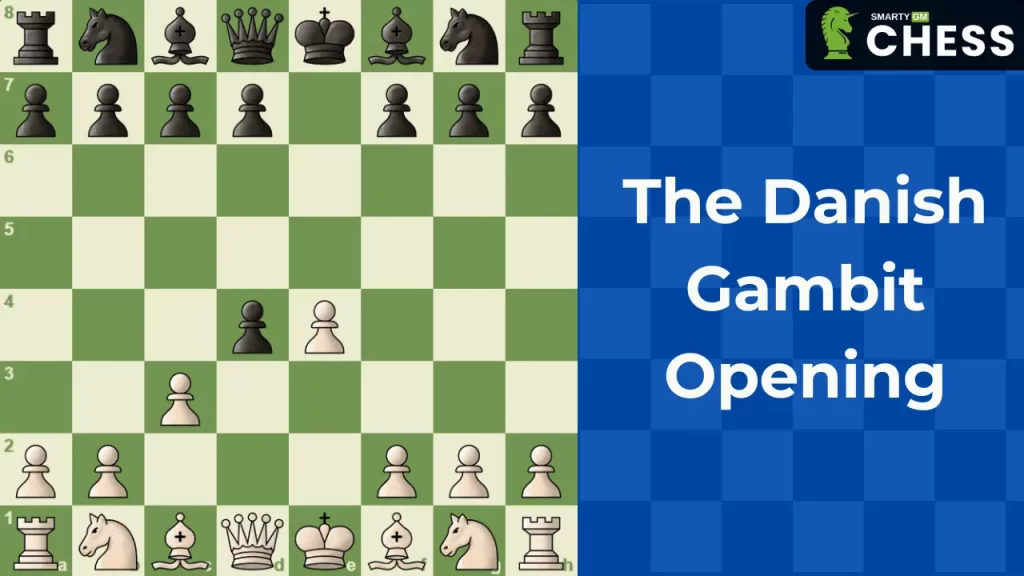The Danish Gambit is an aggressive chess opening where White sacrifices a pawn for rapid development and attacking chances.
It creates dynamic, tactical play favoured by aggressive players to disrupt Black’s position.
In this article, we delve into the intricacies of The Danish Gambit Opening, exploring its history, key concepts, variations, and enduring impact on modern chess strategy.
Read also: The Scandinavian Defense Explain
What is The Danish Gambit?
The Danish Gambit is an aggressive and tactical chess opening that begins with 1.e4 e5 2.d4 exd4 3.c3.
In this gambit, White sacrifices a pawn early to gain rapid development and active piece play.
The Danish Gambit is characterized by its dynamic nature, aiming to create imbalances and launch quick attacks against Black’s position.
How you can set up The Danish Gambit?
To set up The Danish Gambit, you, as White, start with 1.e4, aiming to create dynamic and aggressive play.
After Black’s response of e5, you play 2.d4, offering a pawn sacrifice to gain rapid development and attacking chances.
Now, your opponent will usually play dxc3, then you play Bc4, offering another free pawn, and when your opponent takes it, you play Bxb2.
Now, look at your glorious bishops. Both of them striking the Kingside, your Queen can get into the mix as well, putting more pressure.
The Danish Gambit Variations
There are many responses from Black, and we will cover most of them:
The Nf6 Variation
If black, play Nf6; you play e5 and chase away the Knight. After that, the Knight will go to e4 (if he goes g8, it’s just wasting a move).
Then, you will sacrifice your bishop on f7 to get a fork from the Queen on d5 and take the hanging Knight.
In this position, you are still a pawn down, but the development for our opponent is still slow, and he can’t castle.
The Bb4+ Variation
In this position, I recommend you cover your King with the knight to d2 (not to c3) to leave this diagonal for your bishop to stay active.
Now, Black plays Nf6 to develop his pieces and tries to threaten the e4 pawn. In this situation, you can easily attack the Knight by playing e5.
After Black plays Ne4 (his only good move), you can sacrifice your Bishop by playing Bxf7+. And now you fork the King and Bishop to take it back.
In this position, We are only down one pawn, but we are so much better than black because he can’t castle and has many pieces stuck on the queen’s side, so we are much better.
The d6 Variation
When Black plays d6, you continue your development with Nf3. Then, usually, your opponent tries to pin your Knight and Activate his Bishop by playing Bg4.
After that, we sacrifice our Bishop on f7 and fork the Black Bishop.
Note: if Black doesn’t see you pin and take the Knight with d6 pawn, you will get a free Queen by playing Qxd8.
In this position, Black pieces are passive, and he can’t castle, and we have a huge lead in development.
The Nc6 Variation
If your opponent plays Nc6 and Nf6 (natural development moves), you will play e5, chasing the Knight away.
When your opponent plays Ne4, you sacrifice your bishop on f7 again and fork the Knight on e4 by playing Qd5.
In this position, your opponent can’t castle, and you’re ahead in development.
Advantages and weaknesses of The Danish Gambit
There are many advantages and disadvantages to The Danish Gambit opening, including:
Advantages
- Rapid Development.
- Forcing Black to react to aggressive threats.
- Disruption of Black’s Pawn Structure.
- Dynamic Play.
Disadvantages
- Material Imbalance.
- Open Lines for Black.
- Complexity
Read also: Van’t Kruijs Opening: Basics, Middlegame, and Traps
The Danish Gambit Traps
There are many traps in The Danish Gambit opening that beginners and even professionals fall into, Which we will present to you today:
Trap 1 – Bishop Sacrifice
Sacrifice the Bishop by playing Bxf7+, then Take the Queen.
Trap 2 – Fork the Queen
If the King takes the Bishop on f7, you can fork his Queen by playing Kg5+.
Trap 2 – Checkmate in 12 moves
This trap get you a checkmate in 12 moves:
Famous games played using The Danish Gambit
Several famous games have featured The Danish Gambit, showcasing its aggressive and dynamic nature. Here are a few games with this opening:
Tony Lin (2028) vs. Laurentiu Grigorescu (2027)
Thomas Lochte (1960) vs. Ruben Valhondo Morales (2124)
How to beat The Danish Gambit
The recommendation for how to beat the Danish Gambit is to play Qe7 instead of dxc3:
The most popular move by White is Bd3 to defend their e4 Pawn. This is a bad move that allow us to target the pawn on d4 by playing d5.
Now, White tries to break the pin by moving the Queen to e2, allowing us to play dxe4.
After some moves, we get a very good position, we can trade our pieces, and castle Queen-side.
Read also: The Caro-Kann Defense: Basics, Middlegame, and Traps
Best videos to learn The Danish Gambit
Resources
Frequently asking questions (FAQ)
The Danish Gambit is a sharp and aggressive opening, offering dynamic play and tactical opportunities, making it a good choice for players seeking dynamic and attacking chess.
Read our article, study books, analyze master games, practice online, and seek guidance from experienced players to learn The Danish Gambit opening effectively.



1 Comment
Pingback: Van't Kruijs Opening: Basics, Middlegame, and Traps - Smarty Chess